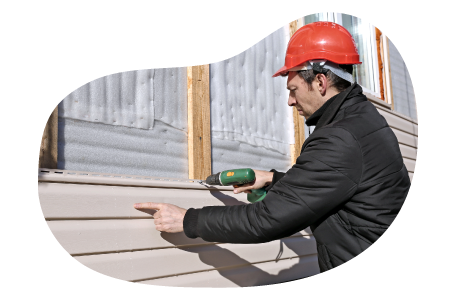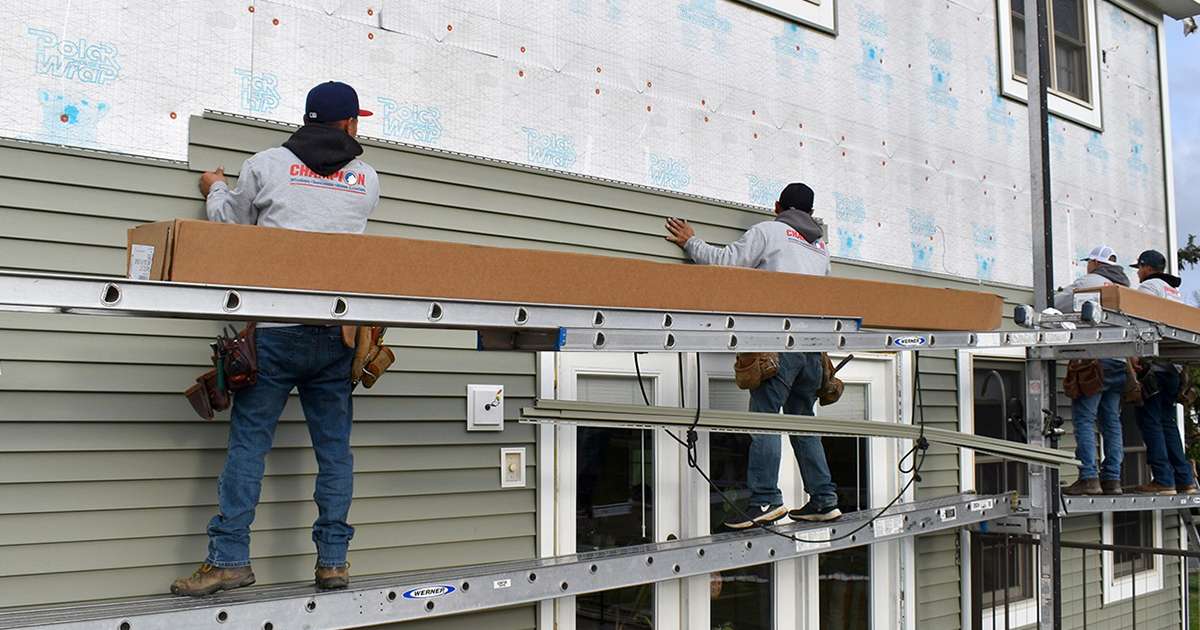The Crucial Guide to the Different Sorts Of Exterior Siding and Their One-of-a-kind Benefits
In the world of home renovation, selecting the ideal house siding is an essential decision that influences both visual charm and practical performance. With so numerous options to consider, which home siding material really stands out for your particular project?
Wood Siding
Timber house siding, a preferred selection for property exteriors, uses a timeless aesthetic that combines all-natural beauty with architectural integrity. This exterior siding material is readily available in various designs, consisting of clapboard, roof shingles, and board-and-batten, enabling property owners to personalize their façade to match their style preferences. Timber exterior siding is usually crafted from resilient varieties such as cedar, redwood, or ache, which are recognized for their durability and ability to hold up against environmental stress factors.
Among the primary advantages of wood siding is its exceptional insulation residential or commercial properties, which can add to energy performance and lower home heating expenses. Furthermore, timber house siding is naturally degradable, making it an ecologically friendly option when sourced sustainably. Normal maintenance, consisting of painting or discoloration, can extend its lifespan and enhance its look, allowing home owners to maintain the natural beauty of the wood.
Nevertheless, potential drawbacks consist of sensitivity to parasites, rot, and weather condition damages, demanding appropriate therapy and upkeep - morris siding contractor. In spite of these worries, when correctly looked after, wood house siding can supply a stunning and durable solution that enhances the character of a home while offering a warm, inviting environment

Vinyl Siding
Plastic siding has actually become a leading choice for home owners seeking a low-maintenance outside choice that combines longevity and cost. This versatile product is crafted from polyvinyl chloride (PVC), making it resistant to numerous weather condition problems, including moisture and UV rays. Because of this, plastic exterior siding does not warp, rot, or fade, making sure long-lasting visual appeal.
Among the main benefits of plastic exterior siding is its considerable variety of styles and shades, enabling property owners to achieve the wanted search for their home without the need for constant repainting. Furthermore, plastic exterior siding is very easy to set up, which can significantly lower labor costs during building and construction or remodelling tasks.
Vinyl home siding additionally contributes to energy performance. Many alternatives function insulation backing, which boosts thermal efficiency, helping to maintain comfortable indoor temperature levels and possibly decreasing energy bills. Its smooth surface assists in simple cleansing, calling for just periodic washing with a yard tube to remove dirt and debris.
Fiber Cement Exterior Siding
Fiber cement exterior siding has acquired traction amongst contractors and property owners alike due to its remarkable mix of toughness and visual flexibility. Composed of a mixture of sand, cellulose, and concrete fibers, this siding option is crafted to hold up against extreme climate condition, consisting of high winds, heavy rainfall, and temperature level changes, making it a lasting selection for household exteriors.

One of the key advantages of fiber cement siding is its resistance to bugs, such as termites, and its non-combustible nature, offering enhanced fire safety and security. morris siding contractor. Additionally, it is readily available in a broad selection of shades, styles, and appearances, allowing house owners to achieve their wanted aesthetic without giving up performance
One more benefit is its low upkeep see this website requirements; fiber concrete exterior siding generally calls for painting or discoloration every 5-10 years, which is less regular than various other materials. Its longevity contributes to a reduced total cost of ownership, as it reduces the requirement for regular fixings or replacements.
Eventually, fiber concrete home siding stands for an outstanding financial investment for those looking for a resilient, appealing, and versatile outside option, combining both type and feature to boost the home's aesthetic allure.
Steel House Siding
The attraction of steel home siding hinges on its robust longevity and modern visual charm, making it a preferred choice for contemporary architecture. Available in products such as light weight aluminum and steel, metal exterior siding a knockout post provides a variety of finishes and shades, enabling property owners to accomplish a tailored appearance that matches their style vision.

Energy performance is another significant benefit, as several metal exterior siding items are designed with insulation options that assist control interior temperature levels. This can lead to reduced energy prices over time. Additionally, metal siding is frequently recyclable, making it an ecologically friendly option for sustainability-minded house owners.
The setup process for metal exterior siding can be relatively uncomplicated, resulting in a quicker turn-around time for building and construction tasks. On the whole, steel siding combines functionality and style, making it a practical choice for those seeking a enduring and visually appealing exterior surface.
Block and Rock House Siding
Block and rock house siding attracts attention as a classic selection that enhances the visual appeal of any type of home. Understood for their durability and reduced upkeep, these products provide an Our site extraordinary roi while elevating the home's curb charm. Available in numerous colors, appearances, and patterns, brick and rock can be tailored to match diverse building styles, from conventional to modern-day.
Among the primary benefits of brick and stone siding is their power efficiency. Both products possess all-natural insulating properties that assist manage indoor temperatures, possibly reducing cooling and heating prices. Additionally, they provide remarkable fire resistance contrasted to other home siding alternatives, contributing to boosted safety and security.
Another benefit is their durability. Block and rock can last for decades, commonly calling for very little maintenance past periodic cleansing. Unlike timber siding, they are unsusceptible insects and rot, making sure a durable outside that holds up against the components.
Verdict
In recap, the option of siding considerably affects a home's aesthetic appeal, energy efficiency, and upkeep needs. Each sort of house siding-- whether timber, plastic, fiber brick, cement, or steel and stone-- supplies one-of-a-kind advantages customized to various property owner preferences and ecological problems. Recognizing these alternatives enables informed choices that enhance both the resilience and visual appeal of household exteriors. Inevitably, picking the appropriate home siding is necessary for achieving a balance in between capability and style in domestic architecture.
One of the main benefits of wood house siding is its outstanding insulation homes, which can add to energy performance and lower heating prices. Additionally, wood house siding is biodegradable, making it an ecologically pleasant option when sourced sustainably.One of the primary benefits of metal exterior siding is its resistance to numerous environmental elements.Power performance is an additional substantial benefit, as numerous steel house siding products are developed with insulation choices that aid regulate indoor temperatures. Each type of house siding-- whether timber, plastic, fiber block, concrete, or steel and rock-- offers distinct advantages tailored to numerous house owner choices and ecological problems.